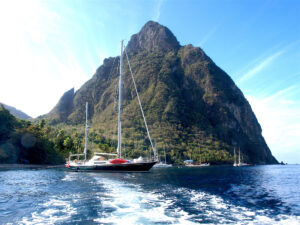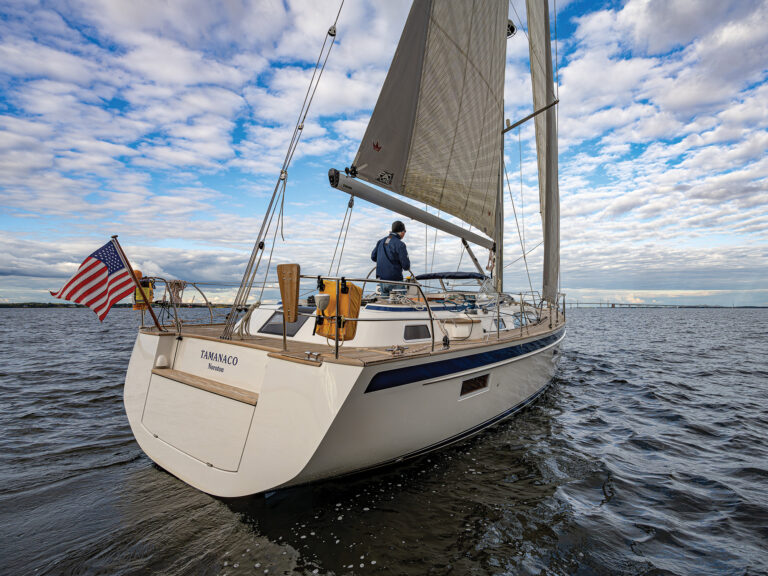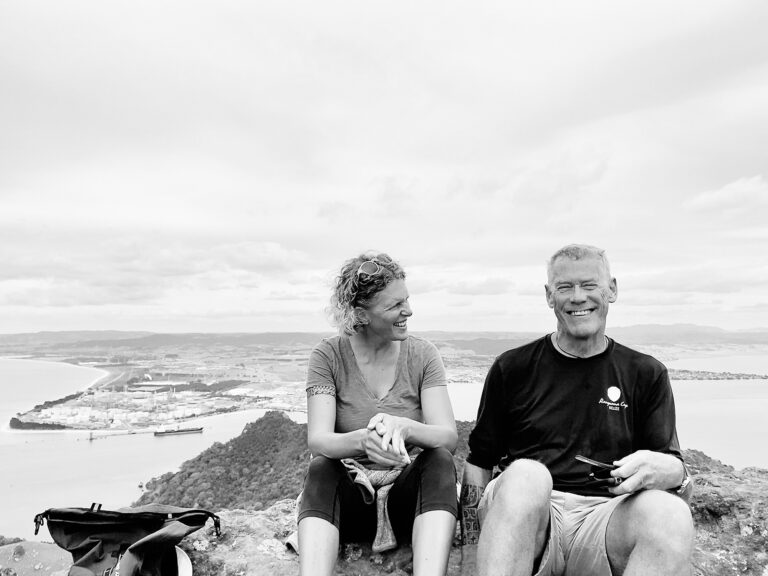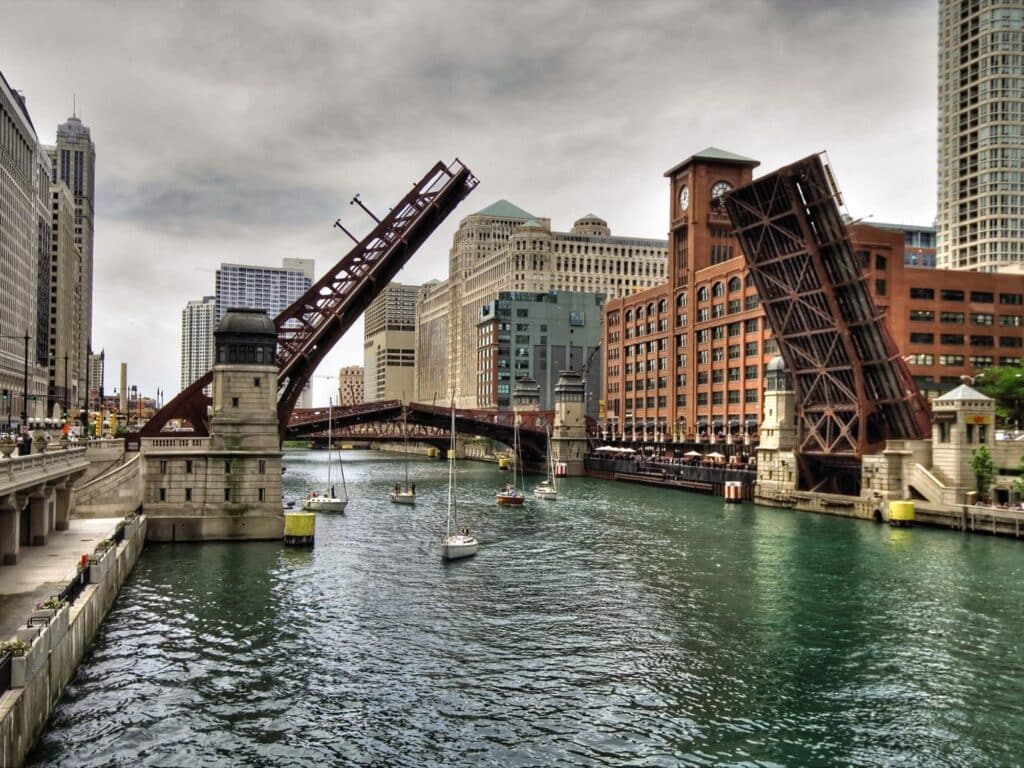
We were cruising down the Tennessee-Tombigbee Waterway, the canal that links Pickwick Lake in Mississippi with Mobile Bay in Alabama. It was November. The sky was gray, and some of the raindrops were starting to resemble snow flurries. The captain was dressed head to heel in gray wool. I was in pink, equally bundled. We stood in the open cockpit of our Nor’Sea 27, insulated mugs of coffee in hand, and sang sea shanties while the captain steered by tiller.
We’d taught our kids these songs on a weekend trip through the desert when they were little. We had sung “Farewell Nova Scotia” as we pulled away from Hovenweep National Monument, chanted “Cape Cod Girls” as we passed through Monument Valley, and learned every line to “All for Me Grog” as we gazed at the red rocks of Moab, Utah. At that time, my husband was a newly obsessed sailor, and we kept our first sailboat on the Great Salt Lake.
Thirteen boats passed us that day on the Tenn-Tom, but we were the only sailboat. The rest were trawlers and motoryachts, all of their captains steering from enclosed and heated flybridges. We were all flying the swallow-tailed burgee of the America’s Great Loop Cruisers’ Association, and we were all going to spend the next year or so on the Great Loop, a 6,000-mile route around the eastern United States.
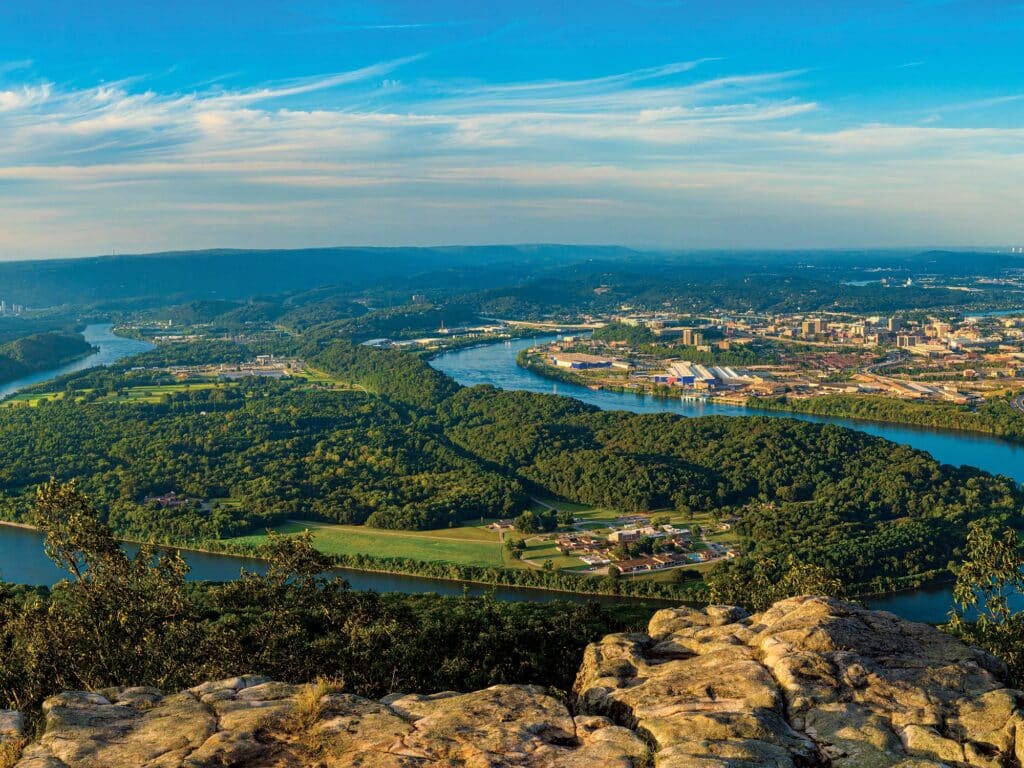
That is where the similarities ended. Ours was not the kind of boat—an open-cockpit sailboat with its mast up—that most people expected to see on the route. Most Loopers didn’t know what to think of us, and most other sailors were headed to the Bahamas, not to Chicago the long way around via the Intracoastal Waterway and the Erie Canal.
But Sonny got it. He waved and honked from the enclosed flybridge of his Mainship 40 trawler as he passed. Later, when we met on the docks in Columbus, Mississippi, he told us how happy he had been to see us.
“My wife was worried about you two,” he said. “She told me, ‘Sonny, don’t you think they’re cold?’ I said, ‘Phyllis, they don’t even know they’re cold. They’re having the time of their lives.’”
Everyone who travels the Great Loop has the time of their lives, but most Loopers choose trawlers and motoryachts in the 40- to 50-foot range. These boats make sense for the route. They provide all the comforts of home for those who cruise on mostly flat water. They’re air-conditioned and heated, with multiple staterooms, large galleys, washers and dryers, multiple heads with showers, and sprawling decks full of furniture. As one Looper said, “It’s like boating in a luxury condominium.”
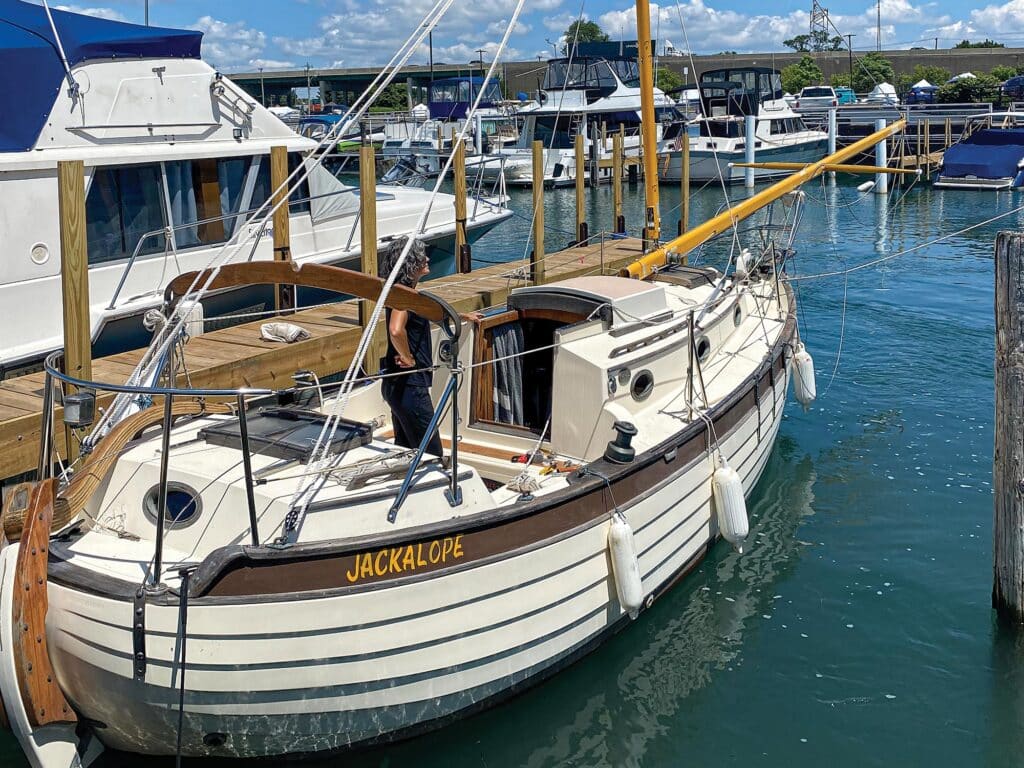
Our decision to cruise the Loop on a sailboat was a compromise of sorts; not just a compromise between captain and first mate, but also a compromise with life itself.
Guy, the captain, wanted to do a big sailing trip, but he has a small business. He needed a route that would offer predictable Wi-Fi and cell service, and allow him to be in US time zones, give him quick access to airports, and make no requirement for a work visa. I was plenty willing to live aboard and sail, but I needed to ease into the idea of big water and passages. I had sailed only on inland lakes.
Also, we wanted to travel cheap. A small diesel engine would beat any motorboat’s 1-nautical-mile-per-gallon rate, and we’d travel for free under sail. That was a real necessity for people saving for retirement.
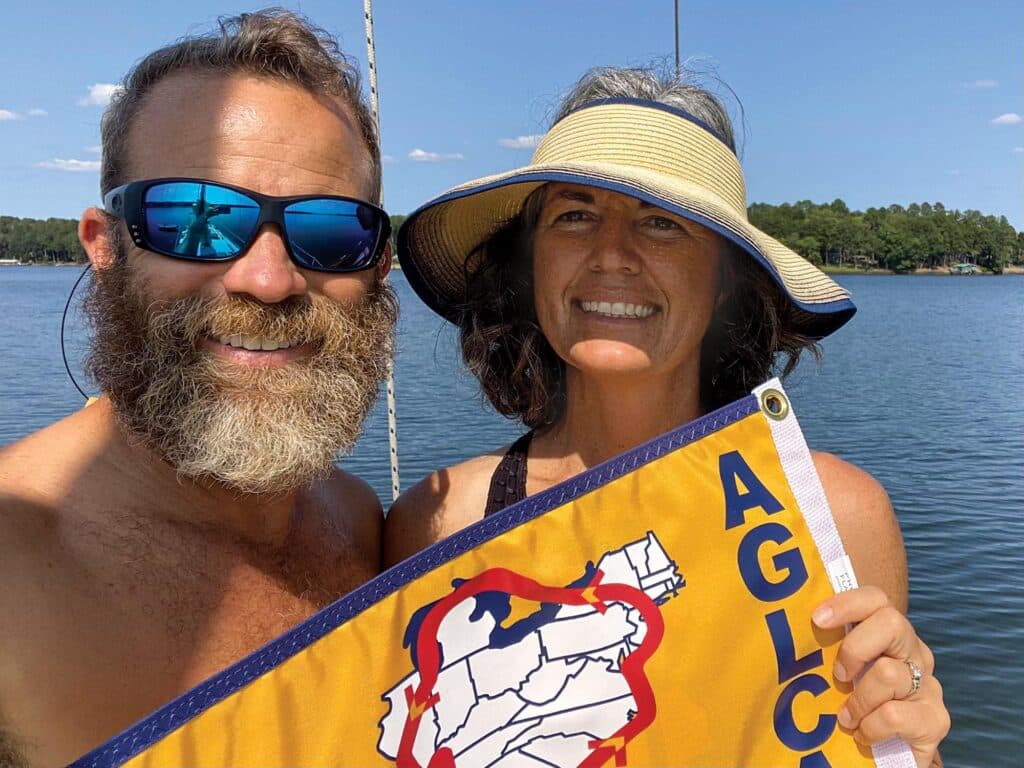
Our boat would need a draft less than 4 feet to anchor out along the shores of the Florida Keys, get through the shallows of the Southern tidal flats, and make countless skinny marina entrances along the route. And we’d have to be able to step the mast for low bridges on the Erie Canal.
All these factors led us to purchase the Nor’Sea 27 we found parked in a gravel driveway in southern Utah, another place where you might be surprised to find yourself humming sea shanties. The boat was designed by Lyle Hess, who created Seraffyn and Taleisin for Lin and Larry Pardey, a little bit of pocket-cruiser royalty. And the boat is trailerable, which was a necessity considering where we found it. The Nor’Sea 27 is also bluewater-capable, a quality that would let us choose big water anytime we had the chance. The 8 hp Yanmar diesel would push us along at 4 knots on motoring days, and would get us 33 miles to the gallon. The sailboat has an on-deck tabernacle that would let us step the 40-foot mast ourselves.
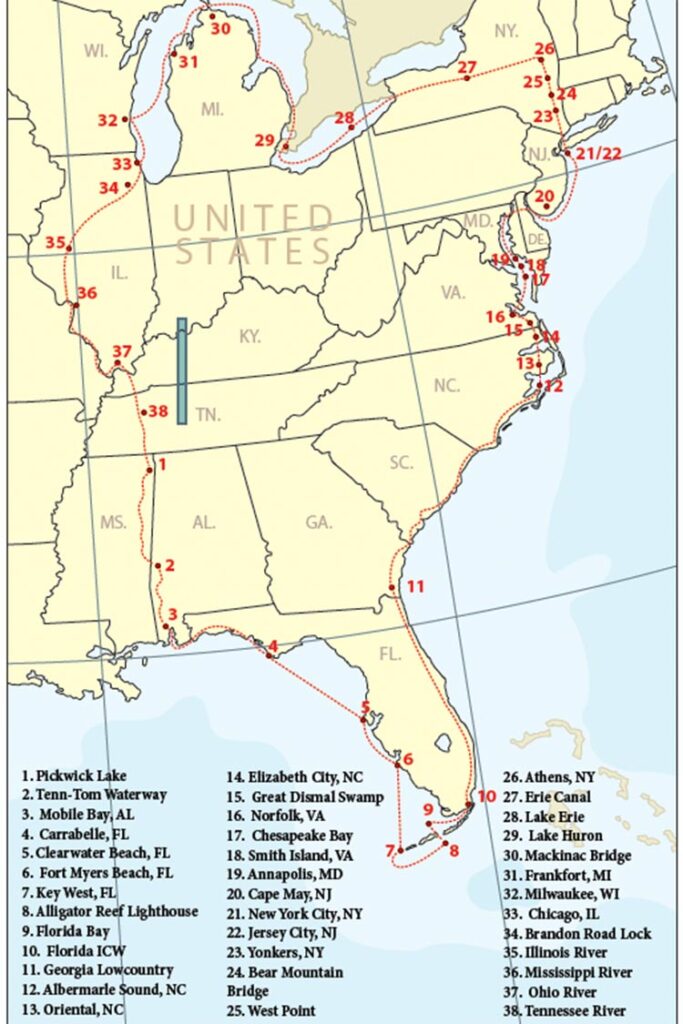
The sailboat had not been modernized, and we weren’t going to spend our time trying to change that fact. We stowed our cold food in the ice chest, spent our nights in sleeping bags in the V-berth, and scrounged onshore for luxuries such as showers and cold drinks. Cruising on a Nor’Sea 27 would be camping, plain and simple. And we didn’t mind. We christened the boat Jackalope and hired a truck to drive her to a marina on the Tennessee River to start our trip.
In late fall, we emerged from the Tenn-Tom ready to cross Mobile Bay and skirt along the Florida Panhandle to Carrabelle. From there, we would make our first open-water passage.
The conversation on the Looper chat groups was all about the weather. When would it be calm (preferably glassy) with wind under 5 knots? Tall boats don’t do well in the waves, and most Loopers wanted to make the smoothest and shortest possible crossing across Apalachee Bay from Carrabelle to Steinhatchee.
In contrast, the crew of Jackalope was well-practiced and ready for some wind and a long Gulf passage. We left Carrabelle at sunset and crossed 150 miles to Clearwater—and it was perfect. Nothing but dolphins leaping in the moonlight. We stayed a few weeks in Clearwater Beach so that our kids could meet us for Christmas, then motored down the Intracoastal Waterway to our next jumping-off point.
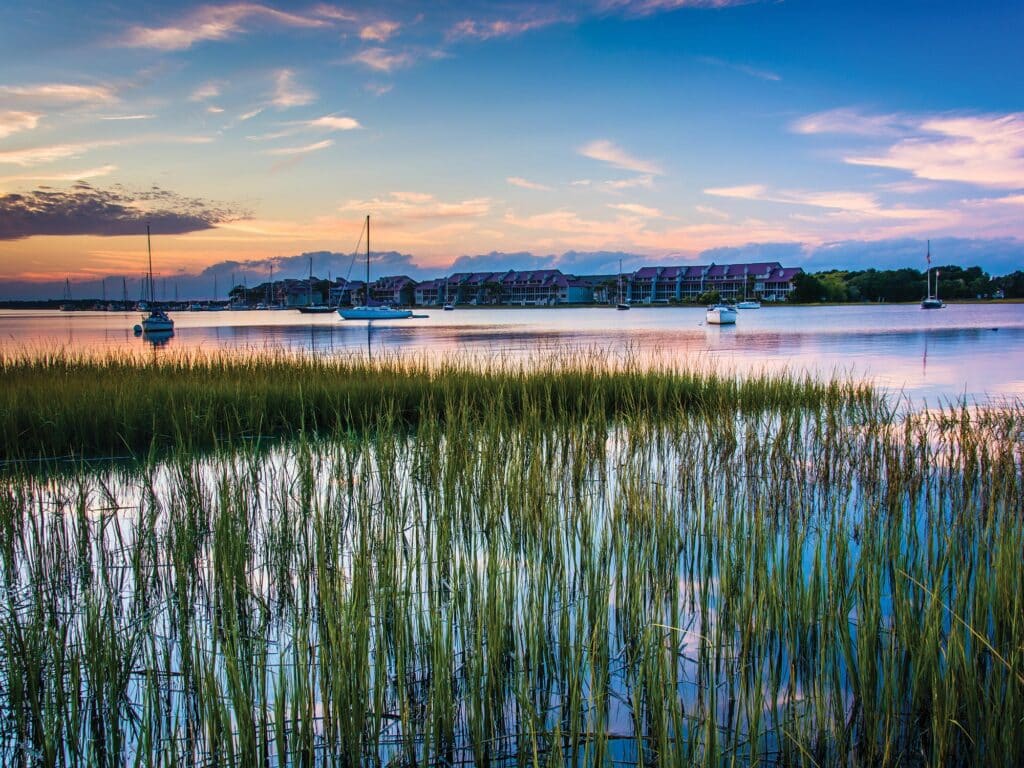
Rather than follow the ICW from Fort Myers Beach to Marco Island, and then motor the yacht channel along the Everglades to Key Largo, we cut out on the Gulf again. This time, we sailed 90 miles from Fort Myers Beach to Key West. After waiting out a storm on anchor in the “bowling alley” between Fleming Key and Wisteria Island, we sailed out of the Gulf and into the Straits of Florida to take a swim at Alligator Reef Lighthouse.
The captain always felt like sailing, so we sailed—on the outside of the Keys, on the inside, in Florida Bay. Sometimes, when the wind was right, we sailed a mile or so on the Florida ICW. Even when we got to Georgia’s Lowcountry, down in the muddy water between parallel banks of salt-grass marsh, we sailed. A lot of times, that narrow and skinny sailing was done just with the jib, to give the one-lung Yanmar a little oomph, but sometimes the wind was steady and the course was straight enough to put up the main and take a bit of a ride.
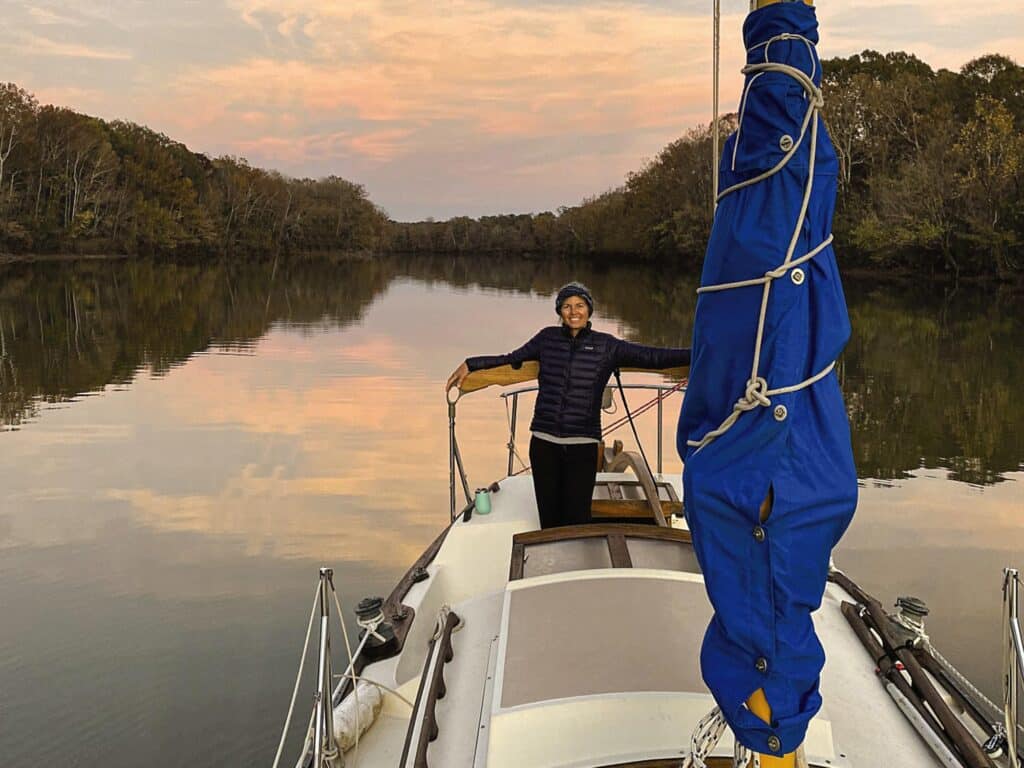
After the mud of the Deep South ICW, it was a pleasure to see the blue shores of North Carolina. In Albemarle Sound, we put up the main and jib, and sailed in the wake of the pirate Blackbeard all the way from Oriental to Elizabeth City.
From Elizabeth City, we motored through the Great Dismal Swamp to Norfolk, Virginia, gateway to the Chesapeake Bay. We’d been looking forward to this since the Tenn-Tom. Back then, in that chilly fall air, we had encouraged each other by talking about it: “We’ll get through this, go all around Florida, through the Carolinas, and then we’re going to sail on the Chesapeake Bay!”
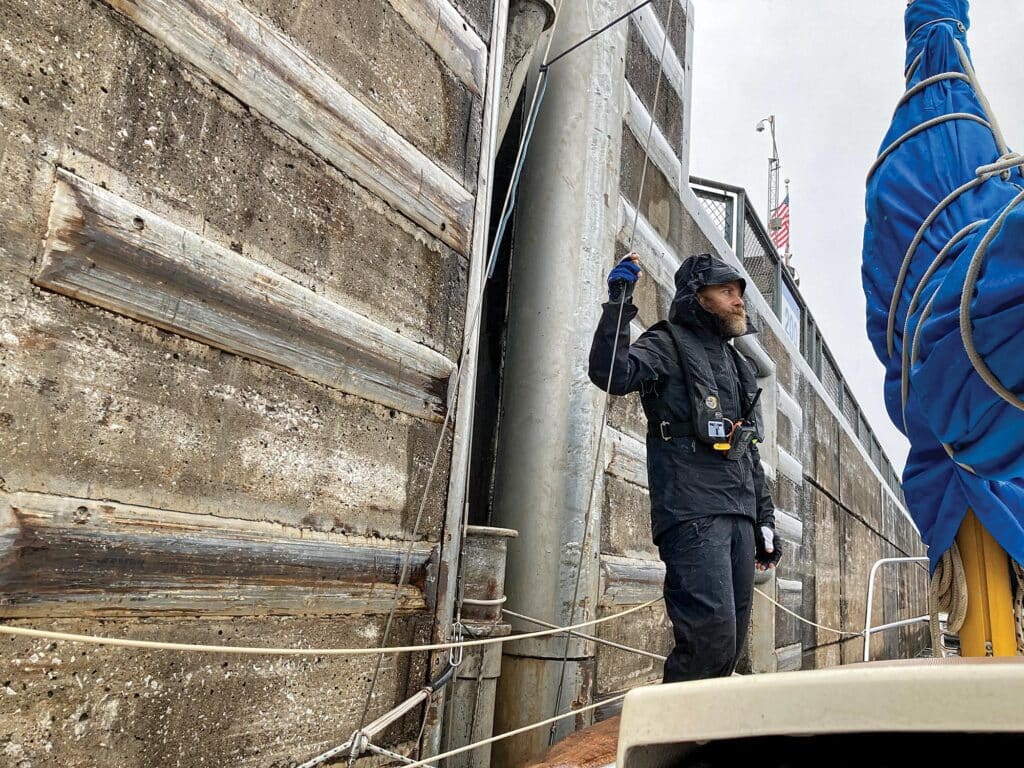
Our first day out of foggy Norfolk cleared into the sunniest skies and the glassiest water imaginable. It was ideal weather for the motor Loopers, but our sails went limp, so we pulled them down, bundled them and sighed. That sigh was not enough breeze to propel us forward, and we had to motor all day. But the wind always comes back, and we ended up with seven days’ worth of sailing on the bay. We zigged and zagged, south to north, past Victorian lighthouses and alongside local crabbing boats. We even nosed into the bakery dock at Smith Island for some of its famous 10-layer cake.
And then, there was Annapolis, Maryland. It was a thrill, and a little bit intimidating, to arrive in American sailing’s home port. But once we docked, Jackalope got her due. One sailor told us that ours was the prettiest boat on the docks. Another leaned close and said, “That’s a cult boat.” Jackalope blushed at the rare but deserved compliments.
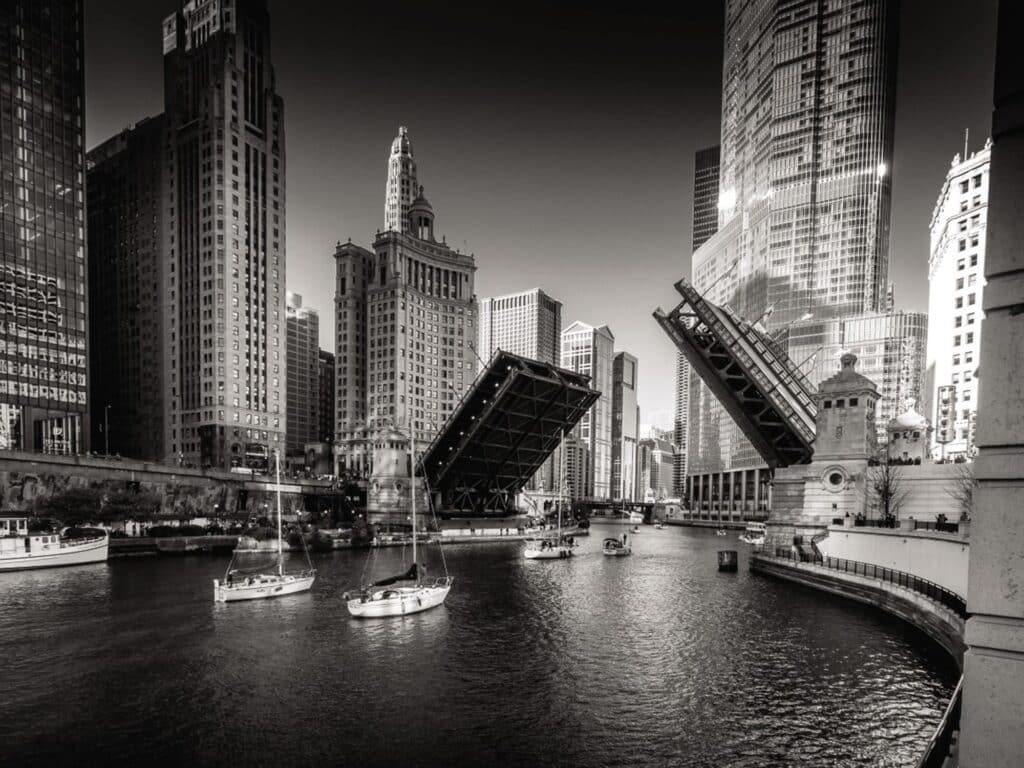
Beyond the Lens
If we were excited to sail on the Chesapeake Bay, the thought of sailing into New York Harbor was surreal. And yet, we did it, slightly loopy after an overnight Atlantic passage from Cape May, New Jersey. We were planning to anchor out at Sandy Hook and sleep the afternoon away, but the wind was just right, so I made cups of strong coffee, and we headed toward the Verrazano-Narrows Bridge and up the Hudson River.
We tacked east toward Coney Island, west toward Staten Island, east again toward Red Hook, west toward the old Bayonne marsh. Dodging a Norwegian cruise ship, we tacked east toward Brooklyn, and then, in the culminating moment, the captain brought us right up next to the Statue of Liberty—our sails up, her torch held high. He had to manage tour boats, personal watercraft and more, but he did it without the engine or bow thrusters. Just the magic of being hove-to.
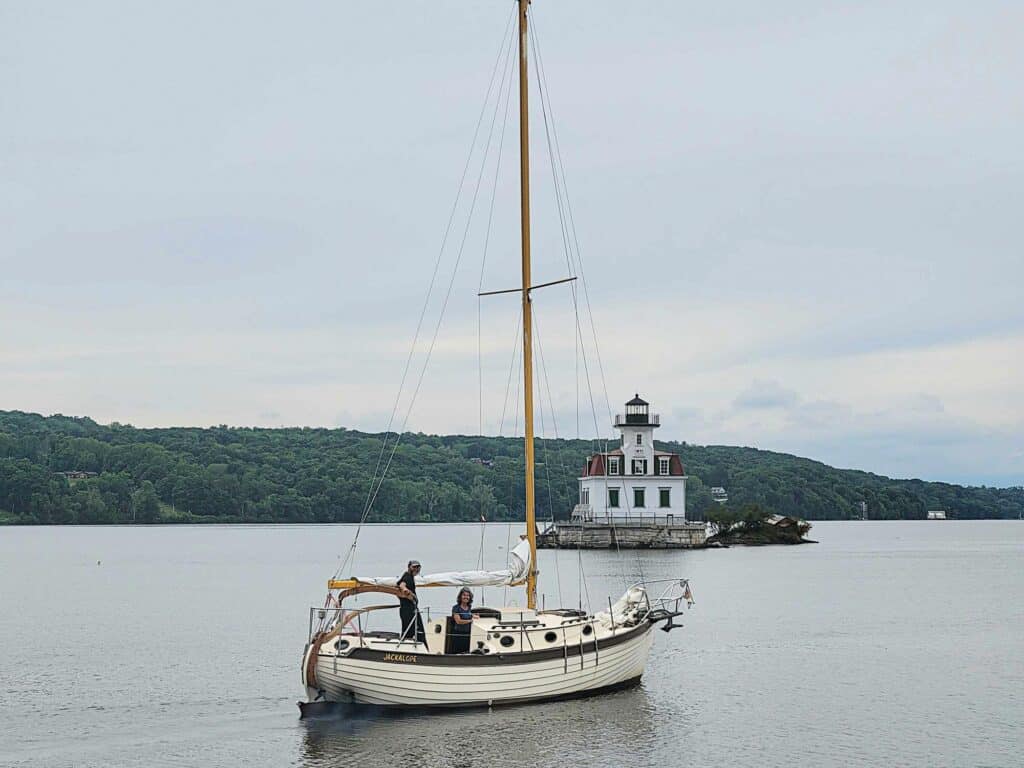
We snapped a few pictures of ourselves looking relaxed while we were actually keeping an intense watch in every direction, and then sailed off toward Manhattan so we could tack into the marina on the Jersey City side of the Hudson.
After spending two days in New York City, we aimed ourselves north. By the time we got to Yonkers, New York, the cityscape had mellowed into countryside. We anchored out under the Bear Mountain Bridge and, the next day, gave West Point a salute as we floated past. Then it was time to unstep our mast at the town dock in Athens, New York, in preparation for cruising the Erie Canal. When the work was done, we went ashore for beers at the brewery.
The narrow, skinny sailing was done with just the jib, but sometimes the wind was steady enough to put up the main and take a bit of a ride.
We put our mast back up after the Erie Canal so we could sail the Great Lakes. Our long journey had prepared us for the challenge. We crossed Lake Erie, skirted up Lake Huron, and rounded the top of the mitten state under Mackinac Bridge. At that point, we were concerned about the changing seasons. Weather windows on Lake Michigan are short, and a lock on the Illinois River was scheduled to close for maintenance soon. We made our way, businesslike, down Michigan’s west coast. From Frankfort, we made an overnight passage to Milwaukee, cutting many miles off the route, then sailed south to Chicago.
Cruising through downtown Chicago, every building gleaming gold in the sunrise, was the highlight of the trip. We kept saying it: “This is incredible. This is the best part.” Then we headed down the grimy Illinois River, squeezing through the Brandon Road lock just in time. We made our way down the Mississippi with the current, up the Ohio, and finished where we started, on the Tennessee.
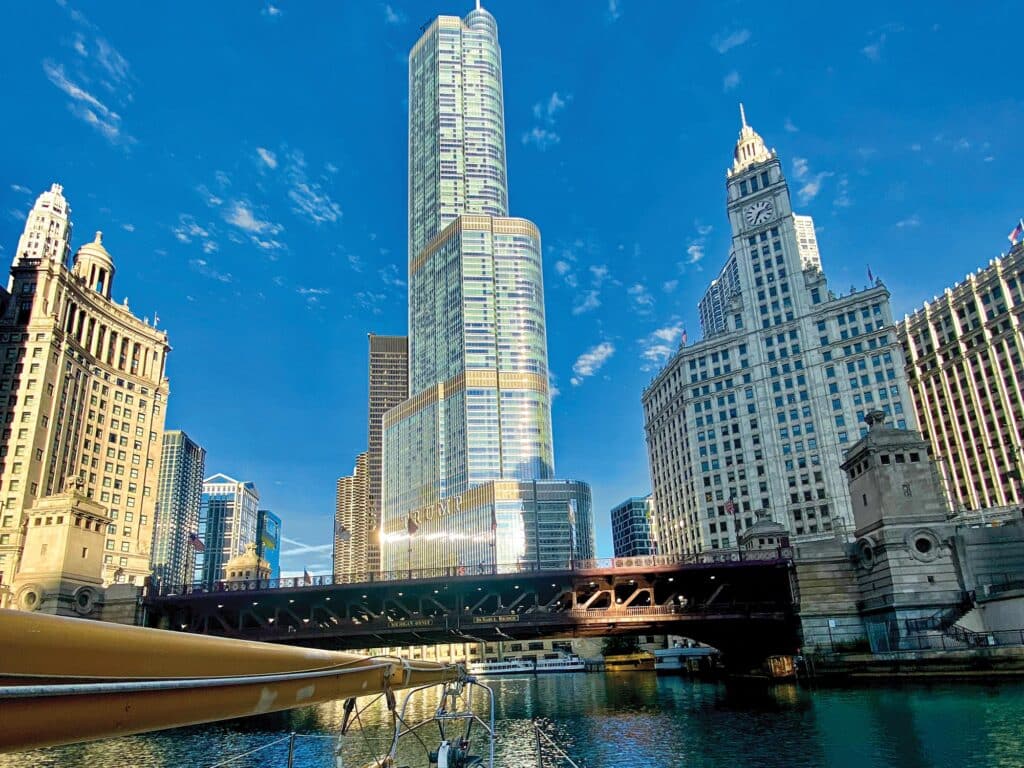
The Loop was 10 trips in one. We cruised canals, mastering locks and tying up to town walls. We had access to bars, restaurants and beaches along the ICW. We cruised past a big bunch of American cities and right through the center of Miami and Chicago. And in just one incredible 6,000-mile, 12-month cruising season, we sailed on the Gulf of Mexico, the sound side of the Outer Banks, up the Chesapeake Bay, on the Atlantic, and in three of the Great Lakes—all of it without worry of hurricanes, encroaching winter weather and customs officials.
A jackalope is an improbable little creature: a mythical combination of jackrabbit and antelope. Sailing the Great Loop was an improbable adventure for an improbable boat. And we had the time of our lives.
Bianca Dumas and her family spent eight years traveling the US by sailboat, canoe, kayak, bicycle and on foot. She plans to settle down and write about all of it.

